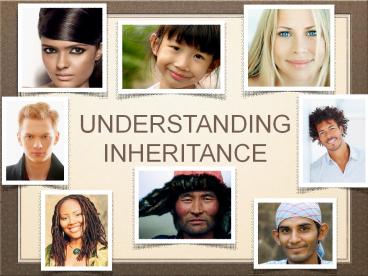Understanding Inheritance - PowerPoint PPT Presentation
1 / 36
Title:
Understanding Inheritance
Description:
Early Genetics. Selective breeding was the earliest form of understanding about genetics. Selective breeding (a form of . artificial breeding) is when people breed ... – PowerPoint PPT presentation
Number of Views:262
Avg rating:3.0/5.0
Title: Understanding Inheritance
1
Understanding Inheritance
2
Traits
3
Detached Earlobes
4
Tongue rolling
5
Dimples
6
Cleft Chin
7
Cross Left thumb over right
8
See Colours Red and Green
9
Straight Hair Line vs Widows Peak
10
Key Terms
- Selective breeding
- Artificial breeding
- Pure Bred
- Gregor Mendell
- Traits
- Self-fertilization vs. Cross Fertilization
- Monohybrid cross
- Dihybrid cross
- P generation
- F1 and F2 generation
- Dominant vs. recessive traits
- Genotype vs. Phenotype
- Heterozygous and Homozygous alleles
11
Early Genetics
- Selective breeding was the earliest form of
understanding about genetics - Selective breeding (a form of artificial
breeding) is when people breed certain animals or
plants in order to produce a desired offspring - For example Horses that developed strong muscles
were bred with other horses that had strong
muscles in order to make race horses.
12
Early Genetics
- Pure bred horses are used by horse breeders to
produce offspring that are quicker, stronger, and
more durable for races.
13
Early Genetics
- Prior to the 1850s and 1860s people did not
understand how genetics worked. - In the 1600s, live sperm was discovered using a
microscope. It was believed that a tiny person
was inside the sperm and that this person would
develop inside the mother - In the 1800s, scientists realized that people
inherit their characteristics from both parents. - However, they believed in blended inheritance
(i.e. if mother has blond hair and father has
black, the child will have brown hair.
14
Gregor Mendel The Pioneer of Genetics
15
Gregor Mendel The Pioneer of Genetics
- Gregor Mendel was the first to conduct a
scientific experiment on inheritance - Mendel discovered inheritance by studying garden
peas
16
Gregor Mendels Observations
- Gregor Mendel noticed that some garden pea plants
were tall while others are short, some pea plants
had different flower position
17
Gregor Mendels Observations
- some pea plants were round while others were
wrinkled, and some pea pods were full while
others flat - Mendel referred to these characteristics as
traits.
18
Gregor Mendels Observations
- Mendel also noticed that pea plants could
self-fertilize and cross-fertilize. - Self-fertilization means that a plant is able to
reproduce with itself and produce offspring. - Cross-fertilization means that a plant reproduces
with another plant to produce an offspring
(sexual reproduction).
19
Cross-Fertilization Vs. Self-Fertilization
20
Mendels Experiment
- Mendel used pea plants that self-fertilize for
his experiment. - This meant that the offspring made by that plant
will be the same as the parent - This is referred to as true breeding or pure
breeding. - Mendel then selectively fertilized a pure bred
green pea plant with a pure breed yellow pea
plant. - In Genetics this is called a cross. (a.k.a cross
fertilization)
21
Mendels Experiment
- Cross Fertilization
22
- Before we look at the results let us clarify some
key terms
23
Key Terms
- Since Mendel was only examining the colour of the
pea pod, it is called a monohybrid cross. - If for instance Mendel was examining both the
colour and the size of the pea plant, then it
would be called a dihybrid cross.
24
Key Terms
- In a test cross (cross pollination) the parent
generation is called P generation - The first offspring is called F1 generation
- The children of the F1 generation is the F2
generation. - And so forth
25
- Back to the results of Mendels Experiment
26
Mendels Results
- When Mendel cross fertilized pure bred green pea
plants with pure bred yellow pea plants - The offspring were all green pea plants.
27
Mendels Experiment
- Through this experiment Mendel realized that some
traits (i.e green coloured pea plants) are
dominant to other traits (i.e. yellow coloured
pea plants). - The green coloured allele for pea plants is
therefore dominant to the yellow coloured allele. - The yellow coloured allele is therefore
recessive.
28
Mendels Experiment (Part 2)
- Mendel then crossed two of the F1 generation pea
plants from the original experiment and - The result was that ¾ of the offspring were green
and ¼ were yellow
29
Genotype vs. Phenotype
- Alleles are often represented using upper-case
letters and lower-case letters. - Recall Mendels experiment
- Which colour allele is dominant?
30
Genotype
- Since the green allele is dominant, we can
represent it using the letter G. - On the other hand, the yellow allele is recessive
and we can represent it using the letter g. - Remember each trait has 2 alleles
- This makes it possible to have 3 different
combinations - 1. GG 2.Gg 3. gg
31
- Let us look at a different example
32
Genotype vs. Phenotype
33
Genotype vs. Phenotype
- Genotype refers to the combination of alleles and
the phenotype refers to the physical
characteristics (e.g. observable traits) produced
by the alleles.
34
Genotype
- If the gene contains two dominant alleles (e.g.
GG) we call this genotype homozygous dominant. - If the gene contains two recessive alleles (e.g.
gg) we call this genotype homozygous recessive. - If the gene contains one dominant and one
recessive allele (e.g. Gg) we call this genotype
heterozygous.
35
Genotype vs. Phenotype
36
homework
- Pg.207 4, 6, 9, 11

